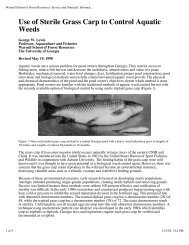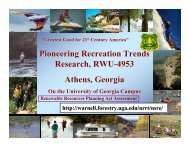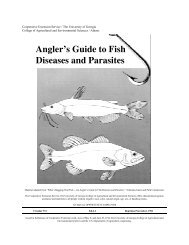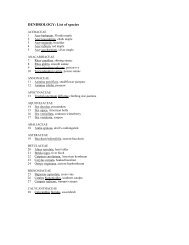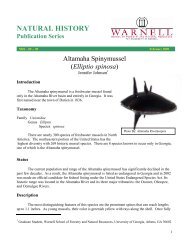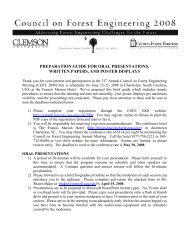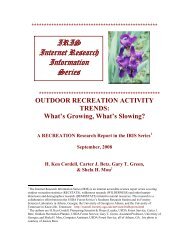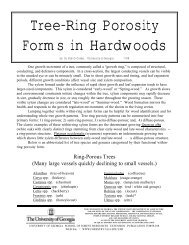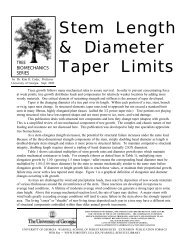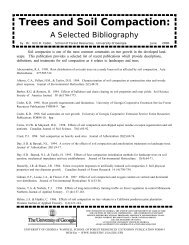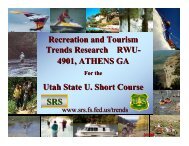Long-Term National Trends in Outdoor Recreation Activity ...
Long-Term National Trends in Outdoor Recreation Activity ...
Long-Term National Trends in Outdoor Recreation Activity ...
Create successful ePaper yourself
Turn your PDF publications into a flip-book with our unique Google optimized e-Paper software.
<strong>Long</strong>-<strong>Term</strong> <strong>National</strong> <strong>Trends</strong> from the 1980s to Now<br />
The NSRE.—Nationwide <strong>Recreation</strong> Surveys (NRS) were conducted <strong>in</strong> the United States <strong>in</strong><br />
1960, 1965 and <strong>in</strong> 1982-83 (USDI 1986). Results from those surveys have provided the<br />
opportunity to view trends <strong>in</strong> American’s outdoor recreation activity participation because the<br />
survey data were collected <strong>in</strong> a consistent way over those years. In 1994 the name of the<br />
Nationwide <strong>Recreation</strong> Survey was changed to the <strong>National</strong> Survey on <strong>Recreation</strong> and the<br />
Environment (NSRE). <strong>Recreation</strong> activity participation data has cont<strong>in</strong>ued to be collected <strong>in</strong> a<br />
consistent and comparable way as was done with the former Nationwide <strong>Recreation</strong> Survey (the<br />
way questions are worded, etc.). Thus, by compar<strong>in</strong>g participation estimates between the NRS<br />
and the NSRE, we are able to track trends up to the present time.<br />
For this paper we start with the 1982-83 NRS. The list<strong>in</strong>g of activities <strong>in</strong> that earlier survey was<br />
much shorter than is found <strong>in</strong> the current NSRE. As well, some activity def<strong>in</strong>itional changes<br />
have occurred, often because of new activities people have taken up, or because of the<br />
emergence of components of a former activity group<strong>in</strong>g as major activities <strong>in</strong> themselves. A<br />
good example of the latter is the activity called “Bird watch<strong>in</strong>g and other nature study activities”<br />
<strong>in</strong> the 1982-83 NRS, which now has been split <strong>in</strong>to bird watch<strong>in</strong>g, wildlife view<strong>in</strong>g, and other<br />
nature activities.<br />
F<strong>in</strong>d<strong>in</strong>gs.—Table 1 shows percentages of the U. S. population and number of participants <strong>in</strong> 33<br />
outdoor recreation activities which could be compared over time (start<strong>in</strong>g <strong>in</strong> 1982-83). These<br />
activities are <strong>in</strong> descend<strong>in</strong>g order accord<strong>in</strong>g to change <strong>in</strong> total number of participants (shown <strong>in</strong><br />
the last column of the table). These statistics are for the U.S. population 16 or older. The<br />
population numbers from the 1982-83 survey were for people 12 or older, but were adjusted to<br />
be comparable with the more recent surveys by reduc<strong>in</strong>g estimates of number of participants<br />
proportionate to the number of people between 12 and 15 years old from the 1982-83 NRS.<br />
At the top of the list, as it typically has been over the years, is the activity of walk<strong>in</strong>g outdoors.<br />
Both the percentage of population and number of participants have steadily <strong>in</strong>creased over time<br />
s<strong>in</strong>ce 1982-83. Follow<strong>in</strong>g <strong>in</strong> terms of growth of number of participants is view<strong>in</strong>g or<br />
photograph<strong>in</strong>g wild birds, attend<strong>in</strong>g outdoor sports events, day hik<strong>in</strong>g, attend<strong>in</strong>g outdoor<br />
concerts/plays/other events, and visit<strong>in</strong>g outdoor nature centers. The next activities <strong>in</strong> terms of<br />
growth of number of participants are swimm<strong>in</strong>g <strong>in</strong> natural waters, sightsee<strong>in</strong>g, bicycl<strong>in</strong>g, runn<strong>in</strong>g<br />
or jogg<strong>in</strong>g and picnick<strong>in</strong>g. The next three activities <strong>in</strong>volve use of motors and <strong>in</strong>clude boat<strong>in</strong>g,<br />
driv<strong>in</strong>g for pleasure, and driv<strong>in</strong>g off road. Four activities decl<strong>in</strong>ed between 1982-83 and 2005-<br />
09---tennis, ice skat<strong>in</strong>g, cross-country ski<strong>in</strong>g, and snowmobil<strong>in</strong>g.<br />
As with all social phenomena, there are cycles. Cycles can be driven by economic conditions,<br />
technology changes, population growth, cultural evolution, and other changes. This can be seen<br />
<strong>in</strong> long-term trend <strong>in</strong> hunt<strong>in</strong>g and fish<strong>in</strong>g, which now shows short-term decl<strong>in</strong>es <strong>in</strong> some forms of<br />
these activities. Where these activities were once viewed as the primary recreational pursuits,<br />
now view<strong>in</strong>g and photograph<strong>in</strong>g birds has become the fastest long-term grow<strong>in</strong>g activity,<br />
grow<strong>in</strong>g 287 percent s<strong>in</strong>ce 1982-83 and hav<strong>in</strong>g more participants now than both hunt<strong>in</strong>g and<br />
fish<strong>in</strong>g comb<strong>in</strong>ed. Next fastest grow<strong>in</strong>g <strong>in</strong> terms of percentage <strong>in</strong>crease is day hik<strong>in</strong>g at almost<br />
210 percent s<strong>in</strong>ce 1982-83. The next four fastest percentage growth activities <strong>in</strong>clude<br />
1



